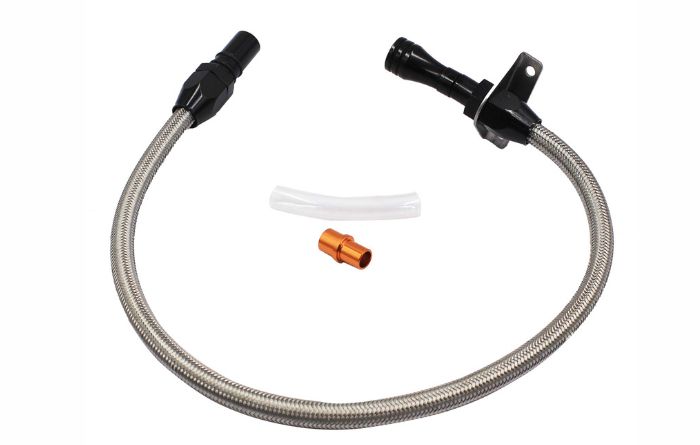Tranny tubes are an essential part of any vehicle’s transmission system.
These tubes are designed to facilitate smooth fluid transmission, protect critical parts like torque converters from damage, and improve the overall performance of a vehicle.
There is a wide variety of tranny tubes available, each crafted from different materials and designed to meet the varying needs of vehicles.
Whether you are a car enthusiast or a professional mechanic, understanding the different types of tranny tubes, their uses, and how to choose the right one for your vehicle can significantly improve the performance and longevity of your automobile.
This guide will dive deep into the characteristics of various types of tranny tubes, their uses, materials, and much more.
What is a Tranny Tube?
A Tranny Tube is essentially a stainless steel pipe designed to prevent torque converters from experiencing issues like shuddering. It is fitted with a Schrader valve to ensure optimal security and functionality.
The selection of the appropriate tranny tube is crucial for the proper maintenance of a vehicle, especially in dusty or rough environments.
Tranny tubes are easy to install, portable, and significantly improve the performance of the torque converter.
Types of Tranny Tubes
There are several types of tranny tubes available, each made from different materials suited to specific vehicle needs:
| Type | Material | Best For | Advantages |
|---|---|---|---|
| PTFE Tranny Tube | PTFE (Polytetrafluoroethylene) | Industrial, high-heat environments | Highly resistant to heat and chemicals |
| PVC Tranny Tube | PVC (Polyvinyl chloride) | Light vehicles, small applications | Affordable and lightweight |
| Stainless Steel Tube | Stainless Steel | Heavy-duty vehicles, harsh environments | Durable, rust-resistant, heat-tolerant |
Each type of tranny tube has distinct properties that make it ideal for certain vehicles and environments.
For example, stainless steel tubes are perfect for heavy-duty vehicles that operate in extreme conditions, whereas PVC tubes are better suited for lighter cars or occasional use.
ALSO READ: What is SQM Club? Benefits, Facts, Objectives & More
Purpose of Tranny Tubes
The primary purpose of a tranny tube is to protect the vehicle’s torque converter from damage.
Torque converters are vital components of an automatic transmission system, converting the engine’s power into torque to drive the wheels.
In environments with excessive dust or dirt, torque converters can become clogged, leading to a phenomenon known as “torque converter shudder.”
This is where the tranny tube steps in, preventing dirt and debris from entering the converter, thereby prolonging its life and maintaining smooth vehicle operation.
Key Benefits of Tranny Tubes
- Improved Lubrication: Tranny tubes enhance the vehicle’s lubrication system, ensuring smooth and efficient operation of the transmission.
- Enhanced Vehicle Performance: With the optimal flow of transmission fluid, the overall performance of the vehicle improves significantly.
- Protection from Dust and Dirt: The primary role of a tranny tube is to keep dirt and contaminants out of the torque converter, reducing wear and tear.
Features of a Tranny Tube
Tranny tubes come with a range of features that contribute to their functionality, longevity, and performance.
These features ensure that the tube operates efficiently within a vehicle’s transmission system, offering protection and aiding the overall performance of the torque converter and related components.
Schrader Valve
A key feature of most high-quality tranny tubes is the Schrader valve. This valve is critical for regulating pressure within the tube, allowing for smooth transmission fluid flow.
It is typically made from Inox Steel, a type of stainless steel that offers excellent corrosion resistance.
In addition, the Schrader valve makes it easier to maintain and monitor the internal pressure, which contributes to better transmission performance.
Patent-Pending Sealant
Many tranny tubes are equipped with a patent-pending sealant. This sealant adds an additional layer of protection to the tube by sealing off areas where dust, dirt, and other contaminants could enter and compromise the fluid transmission system.
The sealant can last for up to two years, making it a valuable feature for those who drive in dusty or rough environments.
Smooth Inner Lining
The inner lining of the tranny tube is designed to be smooth, allowing transmission fluid to flow more freely.
This smooth flow of fluid ensures that the transmission operates efficiently, with minimal resistance, thereby reducing wear and tear on the vehicle’s moving parts.
This feature is especially important in high-performance vehicles or those operating under tough conditions, such as heavy towing or frequent off-road driving.
Heat Resistance
Tranny tubes, particularly those made from stainless steel or PTFE (Polytetrafluoroethylene), are designed to be highly heat-resistant.
Heat is a major concern in a vehicle’s transmission system, as excess heat can lead to component failure.
These tubes are engineered to withstand high temperatures, ensuring that the transmission fluid remains stable even during long drives or in extreme climates.
Corrosion Resistance
Since transmission systems are often exposed to moisture and various chemicals, corrosion resistance is a vital feature of a quality tranny tube.
Tubes made from Inox Steel or stainless steel offer excellent resistance to rust, ensuring that the tube remains functional for many years.
This is especially crucial in regions with high humidity or for vehicles that frequently travel through wet conditions.
Flexibility
While some tranny tubes are rigid, others are designed to be flexible, allowing them to bend and adapt to the specific layout of the vehicle’s engine and transmission system.
Flexible tubes are easier to install and can fit into tight or awkward spaces within the engine bay, making them ideal for a variety of vehicle types.
They also help reduce the risk of cracking or breaking during installation or operation.
| Feature | Description | Benefit |
|---|---|---|
| Schrader Valve | Made from Inox Steel for pressure regulation and durability | Corrosion-resistant, ensures optimal pressure management, and improves durability. |
| Patent-Pending Sealant | Protects from contaminants, lasts up to two years | Long-lasting protection from dirt and debris, reduces maintenance frequency. |
| Smooth Inner Lining | Reduces friction, improves fluid flow | Enhances fluid flow, improves vehicle performance, reduces friction within the transmission. |
| Heat Resistance | Withstands high temperatures, made from heat-resistant materials | Protects against overheating, prolongs the lifespan of the tube and transmission components. |
| Corrosion Resistance | Stainless steel or Inox Steel construction resists rust | Long-lasting durability, protects against rust and corrosion, reduces maintenance costs. |
| Flexibility | Flexible design for easier installation in tight spaces | Easier installation, adaptable to different vehicles, reduces installation time and effort. |
Availability of Tranny Tubes
Tranny tubes are widely available in stores and online. One of the major advantages of purchasing these tubes online is that you can read customer reviews to help guide your decision.
Major platforms like Amazon offer a wide variety of tranny tubes, with customer feedback and even discounts at times.
How to Choose the Right Tranny Tube?
Choosing the right tranny tube can make a significant difference in your vehicle’s performance. Here’s what to consider:
Tube Size
The size of the tranny tube must match the specifications of your vehicle. Different vehicles require different tube sizes, and installing the wrong size can result in inefficiency or even damage to the transmission system.
Type of Tube
You can choose between traditional and synthetic tubes. Synthetic tubes tend to be more expensive, but they offer better performance, particularly in hot environments. Traditional tubes are cheaper but often less durable.
Flexibility
The flexibility of the tube is also an important factor. Some tubes are more flexible than others, making installation easier and offering better adaptability to your vehicle’s transmission system.
| Criteria | Recommendation |
|---|---|
| Tube Size | Should match your vehicle’s specifications |
| Type of Tube | Synthetic for better durability, traditional for budget-conscious buyers |
| Flexibility | Opt for flexible tubes for easier installation |
Other Benefits of Tranny Tubes
Aside from improving the lubrication and protecting the torque converter, tranny tubes can also prevent fluid backflow and overheating.
Both of these issues can cause significant damage to your vehicle if not addressed. Moreover, certain tranny tubes are specifically designed to work with vehicles like Chevy and GMC trucks, adding to their versatility.
Safety and Environmental Considerations
In today’s environmentally conscious world, it is crucial to choose products that are safe for the environment. Many tranny tubes are now made from eco-friendly, biodegradable materials.
When selecting a tranny tube, always read the packaging to ensure the product does not contain harmful chemicals and is safe for both your vehicle and the environment.
ALSO READ: How To Prepare Your Businesses For The Metaverse Trends?
Six Most-Used Tranny Tubes
Here’s a look at some of the top tranny tubes in the market:
| Model | Material | Vehicle Compatibility | Pros | Cons |
|---|---|---|---|---|
| 1409KMT TH350 | Stainless Steel | Chevrolet GM TH350 Tranny, Turbo TH400 | Durable, rust-resistant | May not monitor brake fluid levels |
| TASAN Racing | Stainless Steel | GM/Chevrolet TH350, BBC, SBC | Flexible, corrosion-resistant | Not compatible with TH400 |
| Extreme Amazing | Stainless Steel | Chevy Firewall Mounts | Corrosion-resistant, sleek design | Heavier compared to other tubes |
| Stainless Braided Hose | Stainless Steel | GM/Chevy SBC, BBC TH350/TH400 | Leak prevention, durable build | Less flexible |
| SBC Anngo Flexible | Stainless Steel | GM TH350 Turbo Transmission | Aluminum handle, flexible | May be difficult to use for beginners |
Conclusion
Maintaining your vehicle’s transmission is vital for long-term performance, and tranny tubes play a critical role in that maintenance.
By understanding the various types of tranny tubes available and their specific functions, you can make an informed decision that will keep your vehicle running smoothly and efficiently for years to come.
Whether you opt for a stainless steel tranny tube for durability or a PVC tube for affordability, always prioritize quality and compatibility with your vehicle.







